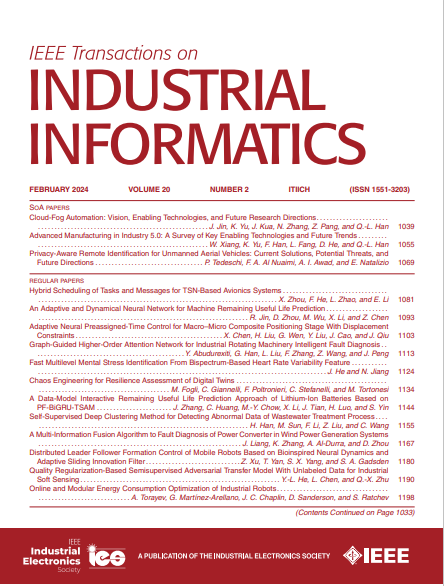基于电信号时间连续性的DC-DC变换器高级故障诊断方法
IF 9.9
1区 计算机科学
Q1 AUTOMATION & CONTROL SYSTEMS
引用次数: 0
摘要
本文着重论述了直流变换器的可靠运行对现代电力电子设备的稳定运行的关键作用。解决了dc-dc变换器故障诊断中一个普遍存在的问题,即倾向于依赖局部特征拟合,而忽略了电信号的时间连续性。从数据处理的角度提出了一种利用自适应小波变换的诊断方法。该技术可以动态调整刻度和平移参数,以适应不同电路条件下电信号的连续变化。从模型改进的角度出发,设计了扩展卷积胶囊网络模型。该模型通过多尺度特征提取、综合全局-局部关注机制和全局向量分析,有效地诊断了故障特征。结果表明,该方法能够有效地提取电信号的时间连续性特征,并在诊断精度、性能指标和应用推广能力方面具有显著优势。因此,本研究为dc-dc变换器的故障诊断提供了一种全面有效的方法。本文章由计算机程序翻译,如有差异,请以英文原文为准。
Advanced Fault Diagnosis Method for DC–DC Converters: Leveraging the Temporal Continuity of Electrical Signals
This article focuses on the crucial role of reliable dc–dc converter operation for the stability of modern power electronic devices. Addressed is a common issue in the fault diagnosis of dc–dc converters: the tendency to rely on local feature fitting while the temporal continuity of electrical signals is neglected. An innovative diagnostic method that utilizes an adaptive wavelet transform from a data processing perspective is proposed. This technique can dynamically adjust the scale and translation parameters to adapt to the continuous changes in electrical signals caused by varying circuit conditions. From the standpoint of model improvement, the extended convolutional capsule network model is designed. Through multiscale feature extraction, integration of global-local attention mechanisms, and global vector analysis, this model effectively diagnoses fault features. It is demonstrated that our method is effective in extracting the time-continuity features of electrical signals, and exhibits significant advantages in diagnostic accuracy, performance metrics, and application generalization capability. Consequently, this study presents a holistic and effective approach for fault diagnosis in dc–dc converters.
求助全文
通过发布文献求助,成功后即可免费获取论文全文。
去求助
来源期刊

IEEE Transactions on Industrial Informatics
工程技术-工程:工业
CiteScore
24.10
自引率
8.90%
发文量
1202
审稿时长
5.1 months
期刊介绍:
The IEEE Transactions on Industrial Informatics is a multidisciplinary journal dedicated to publishing technical papers that connect theory with practical applications of informatics in industrial settings. It focuses on the utilization of information in intelligent, distributed, and agile industrial automation and control systems. The scope includes topics such as knowledge-based and AI-enhanced automation, intelligent computer control systems, flexible and collaborative manufacturing, industrial informatics in software-defined vehicles and robotics, computer vision, industrial cyber-physical and industrial IoT systems, real-time and networked embedded systems, security in industrial processes, industrial communications, systems interoperability, and human-machine interaction.
 求助内容:
求助内容: 应助结果提醒方式:
应助结果提醒方式:


